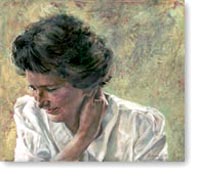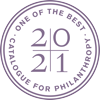The Beginnings according to Web Coleman, husband of Barbara Smith Coleman.
Barbara Jean Smith, mother of three, Washington hostess, artist and sculptor, took her beloved brother Neill to Europe in the late 1980’s, seeking help for his debilitating cancer. Their last stop was the Bristol Cancer Center in England, an unusual weeklong program of the British national health system. She was persuaded to join the patients as one of the caregivers. Here is a synopsis of her own account on what happened…
How Smith Farm Center came to be
A journal entry by Barbara Smith Coleman
 We began in a group session; followed this with a painting hour. Directly after, we met with two therapists to discuss our creations. In the telling, I burst into sobs. This outbreak before strangers who were witnesses was the beginning of my personal journey of healing . . . And so the week unwound: meditation, relaxation sessions and group work, both for those with cancer alone, then with their caregivers. Included was a body of unknown age or sex lying blanketed on the floor. We used to give it pats and words of encouragement (This was a challenge for me, as touching a stranger was a personal taboo. I had a great deal to learn about healing touch!).
We began in a group session; followed this with a painting hour. Directly after, we met with two therapists to discuss our creations. In the telling, I burst into sobs. This outbreak before strangers who were witnesses was the beginning of my personal journey of healing . . . And so the week unwound: meditation, relaxation sessions and group work, both for those with cancer alone, then with their caregivers. Included was a body of unknown age or sex lying blanketed on the floor. We used to give it pats and words of encouragement (This was a challenge for me, as touching a stranger was a personal taboo. I had a great deal to learn about healing touch!).
Midweek, the afghan-covered lump on the floor identified itself. A fuzz-bald head peeked up; soon a young woman was in a chair and though terribly weak began to unfold herself. She was a dancer in “Hair” on the London stage! Day by day we all grew in understanding of each other, and a strong bond developed among us. By week’s end we had a little party, while our dancer taught us steps and said, “You see, I thought I had to be beautiful, or smart, or funny, but now I know I just have to be, to be loved.”
The “ah hah!” Her revelation gave me the command that my future was going to evolve around making this knowledge, via these methods, available in my own country. This one observation compelled me to spend the rest of my life to make it come true, for cancer patients and staff at Smith Farm. I want everyone to live this, to know that you just have to be, to be loved.
The core lessons of the extraordinary week were that people can change in fundamental positive ways. Such changes can become life long. Their open expression in a safe and loving atmosphere is essential to health. Speaking aloud in front of witnesses allows you to really hear and feel, perhaps for the first time. The essentials for healing must be unqualified love and non-judgmental acceptance. Learning to listen totally, in silence, is imperative. We desperately want to be understood. We must not offer advice or “try to fix things”. This I knew was what I wanted.
So the search began. It took me a couple of years to process what I had learned. I worked hard every day of concentrated studio time. I had to continue to create, to make things: my deepest need, avenue to meditation, renewal and my soul. . . Later, taught drawing to medical students and undergrads at Georgetown University.
Dreamed of finding some way to educate them in caring for others. Developing new methods to help people release the vital energy of the creative spirit within. This is the healing power of art.
I returned to my interest in creating a Bristol-like center in the Washington area. Began to attend workshops at The Foundation Center. Wrote a mission statement and went through the legal process to found and begin Smith Farm Center for Healing and the Arts. Applied for a tax-exempt status. Some donations came in. Worked at designing programs to involve artists and people who had a life-threatening illness.
Beginning to write grant proposals, I researched to see if such a program existed in the U.S.A. A friend told me about Commonweal and Michael Lerner, its founder, of whom I had not heard. She emphasized the importance of Commonweal’s Cancer Help Program, a most helpful weeklong retreat, which Michael and Dr. Rachel Naomi Remen had co-founded around 1980.
The next step was to make an appointment with Michael Lerner in California. We met in his Bolinas office, surrounded by papers and books. I remember his graying hair, high energy and, it was clear, a mind, which far outpaced my own. His direct and insightful questions were obviously intended to help sort out what I would like to do.
I asked if he would consider a Washington, DC Commonweal. He demurred, explained that the time was not right. There were not endless applicants those days willing to spend a week doing healing work. (It was Bill Moyer’s TV special on Complementary Medicine that brought the Cancer Help Program to national attention a few years later.)
We then focused on my concerns as an artist. Michael said that one in his group, Dr. Michael Samuels, was working on a program of art and medicine. Perhaps I would like to join forces with him? I agreed to help fund a seminar on “Art as a Healing Force”. A large audience first met at the University of San Francisco in 1990? for overview talks by artists and a slide show of healing art.
A group of about forty came to Commonweal for a weekend of presentations, experiential art therapy and discussions. It was a stimulating mixture of hospital administrators, physicians, healthcare professionals and renowned artists. We closed the seminar with a group sandtray.
Marion Weber had developed sandtray as a therapy tool in Commonweal’s Cancer Help Program (CHP) retreats. Her compassionate leadership had us all leveling with each other and “speaking our truth”. This core group and others met several times in succeeding years.
Creating and making things has a powerful personal benefit. When you write or paint or dance and pursue beauty — has been a powerful force in my life. It is my passion that this knowledge becomes general. Making art is of itself healing. I concluded that it is the process, not the product, which heals.
Recollections from Michael Lerner
When I told Barbara I could not, at that time, join her in starting a cancer program based on the Commonweal model on the East Coast, we agreed to do some healing arts programs together at Commonweal. I also offered to help her as an adviser to start her own cancer support program in any way I could. Barbara purchased a farm on the East Shore of Maryland with the vision of creating her cancer center there.
Unfortunately, her neighbors blocked the permits that would have enabled her to achieve her dream. Barbara was devastated by this development. Shortly after, she was diagnosed with an advanced colon cancer. She attributed the diagnosis in part to this great disappointment.
Barbara underwent very intensive treatment for her colon cancer. Barbara survived with the dedicated support of her husband, Web Coleman. When she had sufficiently recovered, she returned to Commonweal and asked again if I would help her start a cancer center in Washington. This time, I was able to agree. We founded Smith Farm in Barbara’s Georgetown residence. Barbara asked me to serve as President. She was Chairman. Web was Secretary-Treasurer. We hired Shanti Norris as Executive Director. It could not have been a more fortunate choice.
We flew in most of the staff of the Commonweal Cancer Help Program to Washington for the first Smith Farm Cancer Help Program retreat. Rachel Naomi Remen, co-founder and medical director of the Commonweal Cancer Help Program co-led the first retreat with me. On subsequent retreats, we hired more East Coast staff until today, on the tenth anniversary of Smith Farm; the staff is almost entirely from the East Coast.
At Barbara’s death, she left a substantial part of her estate to create the Barbara Smith Fund, which she asked me to serve as President. She also left the building where she had her art studio at 1632 U Street, which houses the Smith Farm offices today.
The Barbara Smith Fund makes an annual grant to Smith Farm to help support its core programs. Shanti Norris continues to serve as Executive Director of Smith Farm ten years after she joined Barbara, Web and me in founding the program.
My personal memories of Barbara are very vivid. She was truly a soul sister to me, a vivid remarkable woman, who was an exceptionally gifted artist, a voracious reader, and an extraordinarily hard worker. She had a profound belief in the immortality of the human soul based on personal experiences. Barbara had an exquisite aesthetic, which expressed itself in her art, in her homes, and in her choices of friends and colleagues. For Barbara, the healing power of art was almost a religion – an experience of the utmost depth. Barbara would be, and perhaps is, proud of Smith Farm’s steady development a decade after she founded it. Her vision of a center for the healing arts has become a reality.

